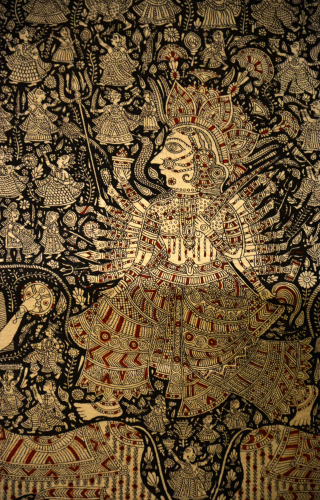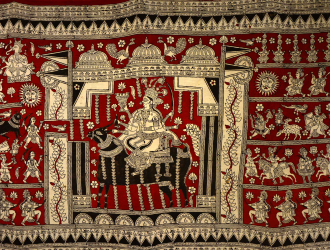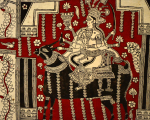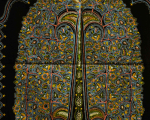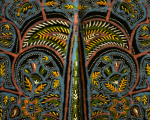This image gallery presents some examples of Painted textiles.
Painted textiles are of two basic kinds: pigment painted or dye painted. Most pigment painted textiles in India–Pichchwais and Phads of Rajasthan, Patas of Odisha–are ancient traditions of painting made for ritual purposes. In these, the preparation of the cloth involves the suppression or control of its natural qualities; the porosity of the cloth is reduced to a minimum while its strength and pliability are reinforced. However, as these works classify more as painting than textiles, they were not included in the exhibition.
The Rogan painting tradition of Gujarat is a pigment painting tradition that is of relatively recent, probably Persian, origin. It is a direct painting technique where an oil-based paste made with mineral colours is applied on the surface of untreated cloth. Rogan patterns have an embossed quality and resemble embroidery.
Dye-painted textiles have been made in the Indian subcontinent for at least three thousand years. The elaborate technique involves the painting of the cloth with mordants or fixing agents before the motifs are drawn and painted or dyed with colour. Dye painted textiles include Kalamkari (known variously as Chintz and Calico) from Andhra Pradesh, Mata ni pachedi from Gujarat, and Sickinaikenpet and Thanjavur Kalamkari textiles from Tamil Nadu.
Indian dye painted textiles were renowned for their depth of colour, intricate designs and colour fastness, and were exported all over the world–to Europe, America, Africa and Asia for centuries. The endless variation of designs produced to suit different tastes and markets underlines the remarkable skill and versatility of the Indian craftsman. Dye painting has sometimes been combined with block printing, as in the Machilipatanam Kalamkari or in Mata ni Pachedi. This was usually in response to increased demand, as printing with block was both cheaper and quicker than dye painting. Indeed, over time, there has been a significant shift away from dye painting to dye printing. But alongside there has also been a movement in the opposite direction, as niche markets have grown for the exclusively dye painted product.
The two Mata ni Pachedi textiles on display make an interesting contrast. The traditional piece in red, black and white is done in a combination of dye painting and block printing, whereas the more contemporary piece in grey with intricate pattern is fully hand-painted.
